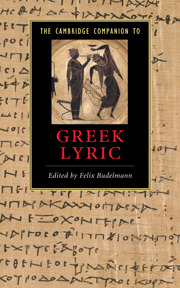Book contents
- Frontmatter
- Introducing Greek lyric
- Part I: Contexts and topics
- Part II: Poets and traditions
- Part III: Reception
- 16 Lyric in the Hellenistic period and beyond
- 17 Lyric in Rome
- 18 Greek lyric from the Renaissance to the eighteenth century
- 19 Sappho and Pindar in the nineteenth and twentieth centuries
- Epilogue
- 20 Lyric and lyrics: perspectives, ancient and modern
- Chronology of select melic, elegiac and iambic poets
- Further Reading
- Glossary
- List of works cited
- Index
20 - Lyric and lyrics: perspectives, ancient and modern
from Part III: - Reception
Published online by Cambridge University Press: 28 May 2010
- Frontmatter
- Introducing Greek lyric
- Part I: Contexts and topics
- Part II: Poets and traditions
- Part III: Reception
- 16 Lyric in the Hellenistic period and beyond
- 17 Lyric in Rome
- 18 Greek lyric from the Renaissance to the eighteenth century
- 19 Sappho and Pindar in the nineteenth and twentieth centuries
- Epilogue
- 20 Lyric and lyrics: perspectives, ancient and modern
- Chronology of select melic, elegiac and iambic poets
- Further Reading
- Glossary
- List of works cited
- Index
Summary
'Lyric poetry', as understood within the modern world, is both like and unlike the lyric poetry of archaic and early classical Greece. The likeness is apparent, if we compare this, by Sappho,
Me, to me he must be a god, this person: Sits so close to you he can hear each time you Laugh and say something
Sweet. Me, just the idea of it thrills me . . .
with this by Robert Burns (1795),
Jockey's ta'en the parting kiss, O'er the mountains he is gane; And with him is a' my bliss, Nought but griefs with me remain.
pare my luve, ye winds that blaw . . .
or this, by Ira Gershwin (1927: music by brother George),
My one and only - What am I gonna do if you turn me down, When I'm so crazy over you?
I'd be so lonely . . .
The samples are all beginnings of longer sequences, but not long sequences. All are about love, and all assume the stance and persona of one particular individual, who has a relationship with another particular individual. The two individuals are presented as ‘I’, the lover, and ‘you’ or ‘he/she’, the beloved. The lover’s voice we hear as the poet’s ‘own’ voice; the beloved’s voice we may hear of (as in the Sappho), but do not hear as such. There is an implied past to this relationship; there is also an explicit present, within which the relationship is unfulfilled or fraught, and the ‘I’ voices an emotional response to the fact. The voicing is articulated in short, regular stanzas, a form that to us readily suggests song – which, indeed, is literally the case with the original, or presumed, realisations of all the samples.
- Type
- Chapter
- Information
- The Cambridge Companion to Greek Lyric , pp. 373 - 385Publisher: Cambridge University PressPrint publication year: 2009
- 2
- Cited by



